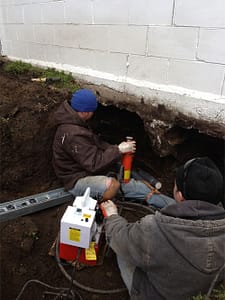Best Basement Waterproofing Fundamentals Explained
Best Basement Waterproofing Fundamentals Explained
Blog Article
The smart Trick of Best Basement Waterproofing That Nobody is Talking About
Table of Contents7 Simple Techniques For Best Basement WaterproofingThe Only Guide to Best Basement WaterproofingBest Basement Waterproofing for DummiesThings about Best Basement WaterproofingThe Best Guide To Best Basement Waterproofing
AdvantaClean's qualified professionals and technicians will certainly locate the water resource. If wall surface or slab cracks are existing, we will certainly infuse polyurethane and epoxies right into the splits and seal the concession, stopping additional moisture from entering.Setting up basement ventilation systems, conditioning systems, or cellar dehumidifier systems to get water out of your basement. Picking AdvantaClean's cellar waterproofing services is an effective way to treat wetness and stop mold from compromising the framework of your home and the health and wellness of your family.
If there's condensation on the exterior of the aluminum foil, you have high moisture in your cellar. If the foil has condensation on the inside surface area (following to the wall surface), the dirt around your home might be normally damp from a high water table or poor dirt drainage.
You can waterproof simply your indoor walls, which may resolve the issue. Or you can waterproof your outside walls, which is a better wager yet more expensive. Below's the inside story on the different kinds: These thick coverings are cement-like. Once they dry out, they adhere permanently to concrete and stonework walls.
Some Known Questions About Best Basement Waterproofing.
Concrete water-proof finishes can't be used to formerly repainted surfaces; check the label. Understood as densifiers, they are suitable just for walls that haven't been painted or secured.
You comb, roll, or spray it on much even more thickly one gallon covers just 75 square feet, not the 300 square feet normal with typical paint. Water-proof paint is great for DIY application. You can apply it over painted surfaces, and paint over it once it's healed (one gallon costs $37).
It can cost $10,000 to $15,000, depending upon the job needed. Outside waterproofing entails digging deep into around your house to the full deepness of the structure walls, then mounting a water-proof coating or membrane layer covered by drainage panels. The panels provide an easy path for water to flow to an outside French drainpipe at the end of your foundation.
Best Basement Waterproofing Can Be Fun For Anyone
We've all been caught in a storm without any umbrella or raincoat. And it's constantly a recipe for disaster: whatever's damp, your coiffure is ruined, and things try this are obtaining musty. A cellar without waterproofing is kind of like that. Minus the spoiled hairdo part. Your basement doesn't want to undergo a rainstorm without proper protection equally as much as you do not wish to.
Outside waterproofing is a waterproofing approach that entails sealing your home from the outside. It's sort of like a moat around a castle. It includes digging a trench around your entire home to the structure (concerning 8 to 10 feet down). The structure wall surfaces are after that cleaned up, sealed, and covered with a water resistant membrane or sealant.

Best Basement Waterproofing for Beginners
It's a more involved procedure that requires excavating up your lawn, which is expensive and taxing. check this Exterior waterproofing involves eliminating whatever bordering the home, consisting of porches, driveways, sidewalks, landscape design, a/c units, decks, and more. If any of the job was done incorrectly and water is still entering your cellar, there isn't much you can do to correct or repair it.
Interior cellar waterproofing includes waterproofing from the inside. Any type of water that leakages into your basement is rerouted prior to it touches your floor. It's type of like putting on a raincoat under your clothing. It entails two points: a water drain track and a sump pump. It works by sealing the inside of your cellar wall surfaces and floors so water that tries to enter is carried out through a sump pump.
It's an efficient method to waterproof your basement. The disadvantage of indoor basement waterproofing mostly has to do with the installment process.
The 4-Minute Rule for Best Basement Waterproofing
To conclude, exterior and interior basement waterproofing are both efficient approaches of securing your home from water damages. Outside waterproofing produces a barrier that avoids water from entering your home, while interior waterproofing redirects water that does enter your home. And it is very important to keep in mind that exterior waterproofing is a pricey and turbulent installment process when compared to indoor waterproofing.
Whichever approach you choose, make sure you pick a reliable and credible service Recommended Reading provider for the job. If you have any kind of questions about basement waterproofing, please get to out to us.
You can load out our kind here. Best Basement Waterproofing, start a chat in the bottom right-hand corner, or call us at 1-800-827-0702
Report this page